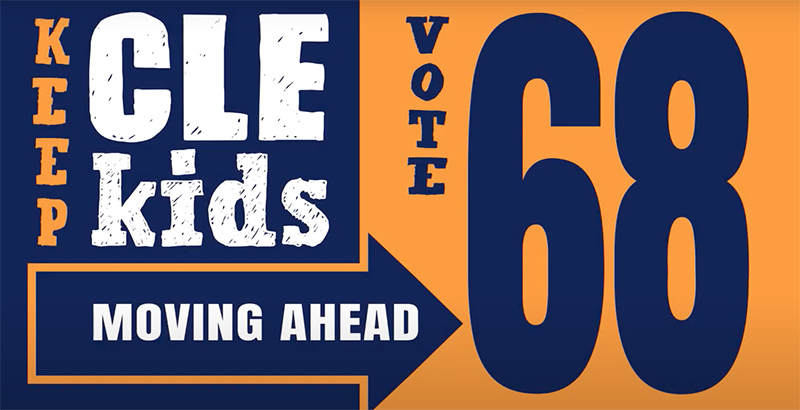Cleveland School District Wanted to Buy Every Student a Computer: COVID-19 Forced It; Tax Increase Would Make It Permanent

For years, Cleveland school district CEO Eric Gordon has wanted to give all students their own laptops or tablets, just like suburban schools do.
Then came COVID-19, and Gordon was forced to scramble so that every child had a device for online classes.
Now, Gordon wants to maintain this “one-to-one” technology and has made it a priority in the district’s campaign for a 12 percent property tax increase, which launched this week.
“We are not going to revert,” he said in an online presentation for the City Club of Cleveland Thursday. “We are now a one-to-one district. We will keep devices and keep connectivity.”
But after spending $14 million this year on laptops and tablets, and another $3 million to connect students to the internet, Gordon now wants those costs to be an investment for the long term. He’s expecting to spend as much as $5 million a year toward that goal out of the estimated $23 million raised by the tax increase, which will appear on the ballot as issue 68.
“Part of what issue 68 will allow us to do is not just get kids devices for this pandemic, but keep us digitally connected long term, like many of our peer suburban districts already are,” he said.
With 73 of the nation’s largest 100 school districts starting the school year online, districts have tossed aside budgets and poured millions into giving computers to students. Whether those technology improvements could be sustained over time often took a back seat to overcoming a shortage of internet devices, the challenges with distributing them to students and the struggles of connecting kids to classes.
For some districts, though, adding computers was already part of a long-term plan to become a one-to-one district over time and COVID-19 just accelerated plans. And having a long-term plan was a major issue for the Los Angeles Unified School District, where winning approval to use school construction bonds for emergency computer purchases this spring came with a demand for a plan to make one-to-one technology sustainable.
Whether the “Keep CLE Kids Moving Ahead” campaign can win support for the tax increase is hard to measure. Convincing voters to pass school tax increases is always a tall task, one that’s even harder after the pandemic put many parents out of work and damaged the economy.
COVID-19 health concerns are also limiting the campaign, moving traditional in-person events to Zoom and turning old-school door-knocking efforts into just leaving campaign literature at homes.
Giving every student an internet device has been a goal of Gordon’s since 2012, but one that he could never achieve. As the poorest and least connected city to the internet in the nation, according to recent census data, Cleveland faced challenges both in providing devices and in giving students internet access.
Budgets were also tight. The district had not asked voters for an operating tax increase since 2012, and it projected a $14 million deficit at the end of this school year, even before COVID-19 hit.
Now that the district has bought and handed out about 30,000 devices to students, along with 12,000 internet hotspots, he and staff are developing and estimating costs of a long-term plan to keep kids connected. That means setting a regular replacement schedule for devices, perhaps every four years, and consistently purchasing the same one or two devices, instead of about five types the district had to buy in a rush.
Purchasing the same brand consistently, he said, will avoid students and staff having to learn the quirks of multiple devices.
Though computers and internet connections will use part of the tax, the district will spend most of the increase on rising operating costs. It is not making detailed promises of what the tax will buy, other than continuing the test-score and graduation-rate gains the district has made since 2012.
The tax will also help cover other pandemic-related costs. District tallies of extra costs because of COVID-19, and some savings, show that the pandemic brought a net loss of about $20 million last school year and this school year.
That includes a $53 million budget hit from an $11 million cut in state aid between the two years, $22 million in extra costs for technology and personal protective equipment last school year, and an extra $20 million budgeted to deal with COVID-19 this school year.
At the same time, $24 million from the federal CARES Act reduced the losses, and the district estimates that it saved $10 million by not needing to pay for busing and substitute teachers.
Mayor Frank Jackson is backing the tax, though that’s expected in a district where he appoints the school board. U.S. Rep. Marcia Fudge, a Democrat, is endorsing the tax, as are several members of the city council.
There is some organized opposition, however. A flyer distributed to some homes in the district says the tax will increase rents and will “force small businesses in Cleveland to close as they get hit with more costs during a bad economy, making it impossible to keep their doors open.”
“Cleveland can’t afford issue 68,” the flyer states, urging a “no” vote.
But the source of the flyers remains anonymous, listing only a corporate name. Attempts to track organizers through corporate records have hit dead ends.
Gordon said he hopes voters will side with the district instead of opponents keeping “in the dark.”
He also took issue with a claim that the tax will cost taxpayers $90 million a year over its 10 years. Technically, that’s true. Issue 68 both renews the 2012 tax increase, which raises $67 million a year, and then adds $23 million more. If Issue 68 fails, the old tax will end and taxes will be reduced.
Gordon says presenting that as a $90 million tax is “really stretching the truth,” since only $23 million is new.
The flyer, he said, is “exploiting the pandemic as a reason not to support schools, instead of seeing all that schools have had to do to feed children, to create learning pods, to get technology in their hands, to connect families that never had internet.”
“This is actually exactly the time to support those families that are often the most marginalized,” he said.
Get stories like these delivered straight to your inbox. Sign up for The 74 Newsletter

;)
